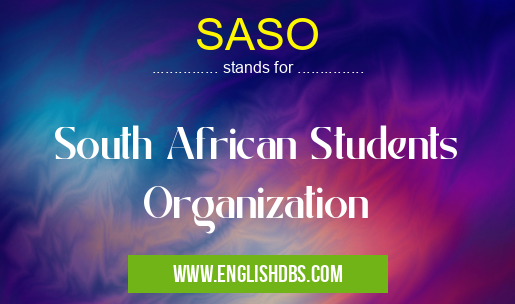What does SASO mean in AFRICAN
SASO (South African Students Organization) was a prominent student organization in South Africa during the apartheid era. It played a significant role in mobilizing black students and advocating for equal rights and opportunities.

SASO meaning in African in Regional
SASO mostly used in an acronym African in Category Regional that means South African Students Organization
Shorthand: SASO,
Full Form: South African Students Organization
For more information of "South African Students Organization", see the section below.
Founding and Objectives
SASO was founded in 1968 at the University of Fort Hare by a group of black students led by Steve Biko. The organization's primary objectives were to:
- Promote black consciousness and self-reliance
- Fight against the oppressive apartheid system
- Advocate for equal access to education and job opportunities
Role in the Anti-Apartheid Movement
SASO became a central figure in the anti-apartheid movement. It organized protests, demonstrations, and boycotts to challenge the government's racist policies. SASO also worked closely with other organizations, such as the African National Congress (ANC), to coordinate resistance efforts.
Key Figures
Prominent members of SASO included:
- Steve Biko: Founder and first president
- Barney Pityana: Theologian and activist
- Mamphela Ramphele: Medical doctor and anti-apartheid leader
Legacy
SASO disbanded in 1977 after government pressure and the detention of its leaders. However, its legacy continues to inspire future generations of activists. SASO's emphasis on black consciousness and student power laid the foundation for the broader anti-apartheid movement and contributed to the eventual downfall of the apartheid system.
Essential Questions and Answers on South African Students Organization in "REGIONAL»AFRICAN"
What is SASO?
The South African Students Organization (SASO) was a student organization in South Africa that played a significant role in the anti-apartheid movement. Founded in 1968, it advocated for black consciousness and student autonomy.
What were the goals of SASO?
SASO aimed to promote black consciousness, encourage student activism, and challenge the apartheid system. It believed that black students needed to develop a strong sense of identity and unity to fight against oppression.
Who were some of the key leaders of SASO?
Notable SASO leaders included Steve Biko, Barney Pityana, and Mamphela Ramphele. Biko, in particular, became a prominent figure in the anti-apartheid movement and was later killed while in police detention.
What impact did SASO have on the anti-apartheid movement?
SASO played a pivotal role in mobilizing black students and raising awareness about the injustices of apartheid. Its protests and campaigns helped to galvanize the anti-apartheid movement and contributed to the eventual downfall of the apartheid regime.
What was the significance of the "Black Consciousness" movement that SASO promoted?
Black Consciousness emphasized the importance of black identity, self-reliance, and liberation. It sought to empower black people to challenge their oppression and create a more just society. SASO's promotion of Black Consciousness had a profound impact on the anti-apartheid movement and inspired other liberation movements worldwide.
Final Words: SASO was a transformative organization that played a pivotal role in the struggle for racial justice in South Africa. Its legacy as a symbol of black consciousness and student activism continues to resonate today.
